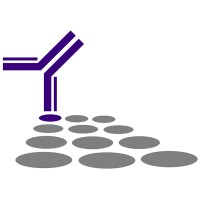Ig Lambda Light Chain / Texas Red / Polyclonal
Product Details
| Description | Goat Anti-Human Lambda-TXRD | |
|---|---|---|
| Conjugate | Texas Red | |
| Clone | Polyclonal | |
| Target Species | Human | |
| Applications | Secondary Ab | |
| Supplier | SouthernBiotech | |
| Catalog # | Sign in to view product details, citations, and spectra | |
| Size | ||
| Price | ||
| Antigen | ||
| Host | ||
| Isotype |
About Ig Lambda Light Chain
Immunoglobulins recognize foreign antigens and initiate immune responses such as phagocytosis and the complement system. Each immunoglobulin molecule consists of two identical heavy chains and two identical light chains. There are two classes of light chains, kappa and lambda. This region represents the germline organization of the lambda light chain locus. The locus includes V (variable), J (joining), and C (constant) segments. During B cell development, a recombination event at the DNA level joins a single V segment with a J segment; the C segment is later joined by splicing at the RNA level. Recombination of many different V segments with several J segments provides a wide range of antigen recognition. Additional diversity is attained by junctional diversity, resulting from the random additional of nucleotides by terminal deoxynucleotidyltransferase, and by somatic hypermutation, which occurs during B cell maturation in the spleen and lymph nodes. Several V segments and three C segments are known to be incapable of encoding a protein and are considered pseudogenes. The locus also includes several non-immunoglobulin genes, many of which are pseudogenes or are predicted by automated computational analysis or homology to other species. [provided by RefSeq, Jul 2008]
Immunoglobulins recognize foreign antigens and initiate immune responses such as phagocytosis and the complement system. Each immunoglobulin molecule consists of two identical heavy chains and two identical light chains. There are two classes of light chains, kappa and lambda. This region represents the germline organization of the lambda light chain locus. The locus includes V (variable), J (joining), and C (constant) segments. During B cell development, a recombination event at the DNA level joins a single V segment with a J segment; the C segment is later joined by splicing at the RNA level. Recombination of many different V segments with several J segments provides a wide range of antigen recognition. Additional diversity is attained by junctional diversity, resulting from the random additional of nucleotides by terminal deoxynucleotidyltransferase, and by somatic hypermutation, which occurs during B cell maturation in the spleen and lymph nodes. Several V segments and three C segments are known to be incapable of encoding a protein and are considered pseudogenes. The locus also includes several non-immunoglobulin genes, many of which are pseudogenes or are predicted by automated computational analysis or homology to other species. [provided by RefSeq, Jul 2008]
About Texas Red
Texas Red (Sulforhodamine 101 acid chloride) is an orange/red emitting dye with an excitation peak at 596 nm and an emission peak at 615 nm. Alternatives to Texas Red that can offer increased photostability and brightness include Alexa Fluor™ 594 (ThermoFisher Scientific), DyLight™ 594 (ThermoFisher Scientific), or CF®594 (BD Biosciences). Texas Red is most commonly used in cellular fluorescence microscopy applications, as the 594 nm laser is rare in flow cytometry. However, it can be sub-optimally excited by the 561 nm yellow-green laser. Texas Red is commonly used as an acceptor in the tandem fluorophore, PE-Texas Red also called ECD.
Texas Red (Sulforhodamine 101 acid chloride) is an orange/red emitting dye with an excitation peak at 596 nm and an emission peak at 615 nm. Alternatives to Texas Red that can offer increased photostability and brightness include Alexa Fluor™ 594 (ThermoFisher Scientific), DyLight™ 594 (ThermoFisher Scientific), or CF®594 (BD Biosciences). Texas Red is most commonly used in cellular fluorescence microscopy applications, as the 594 nm laser is rare in flow cytometry. However, it can be sub-optimally excited by the 561 nm yellow-green laser. Texas Red is commonly used as an acceptor in the tandem fluorophore, PE-Texas Red also called ECD.
Experiment Design Tools
Panel Builders
Looking to design a Microscopy or Flow Cytometry experiment?
Validation References
Reviews & Ratings
| Reviews |
|---|
Looking for more options?
444 Ig Lambda Light Chain antibodies from over 21 suppliers available with over 61 conjugates.





